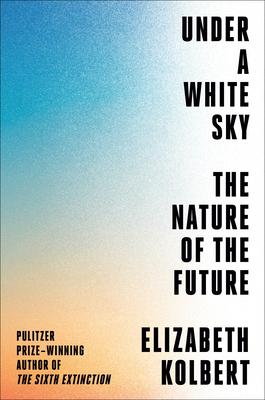I read this book for the Gaia Nature Reading challenge, and it was both fascinating and timely. Kolbert, the Pulitzer Prize winning author of The Sixth Extinction, writes about how science is being used to address some of our biggest environmental concerns, such as invasive species, carbon emissions, and global warming (at the same time, recognizing that science has also created these problems). Her book is broken into three parts, earth, water and sky.

As she goes around the world looking at strategies scientists are working on, Kolbert recognizes the many ways that humans have harmed the environment, but she acknowledges that we can’t undo most of that harm. Even if there was a political will to do so, we’ve gone way too far in terms of genetic and geological engineering to go back to what is “natural”, and it’s not even clear any more what “natural” means. Take for example, genetically modified produce, which is simply man exercising a hand in natural evolution. Instead of looking backwards, we should look forward at how science can help address our current environmental challenges.
Kolbert, like the scientists she interviews, isn’t naïve or even optimistic. With each scientific development, there’s the likelihood of serious unintended consequences. She describes a number of instances where a foreign species is introduced to solve an environmental problem and instead ends up creating much bigger problems (like the giant, poisonous cane toad in Australia, or the silver carp in the Great Lakes). She also notes that even when a scientific idea is very promising, once politicians get involved it often isn’t implemented the way it’s meant to be.
But at the same time, she cautions our thinking in either extreme. While every scientific proposal may not be successful, we can’t go forward by doing nothing. And as one scientist reminds her, many scientific interventions are highly successful, but those aren’t the ones we hear about.
Published in 2021, this book was written during (and delayed by) the pandemic, and I appreciated hearing Kolbert’s thoughts on the pandemic while trying to travel the world speaking to scientists.
There are no simple answers in this book, but Kolbert does an amazing job of making complicated scientific concepts understandable, and this book was inspiring while also terrifying. It is definitely a great companion to books like Hope Jahren’s The Story of More and Jane Goodall’s The Book of Hope. Like those books, Kolbert’s writing style is very accessible and I think this book would be great for anyone with an interest in science and nature.
Thanks to Gum Trees and Galaxies for hosting this year’s Nature Reading Challenge! I pledged to read ten books about nature and environmentalism this year, and I just made it. Here are the books I read:
- The Puma Years by Laura Coleman
- The Island of Sea Women by Lisa See
- Laundry Love by Patric Richardson
- The Book of Hope: A Survival Guide for Trying Times by Jane Goodall and Douglas Abrams
- Diary of a Young Naturalist by Dara McAnulty
- Cannery Row by John Steinbeck
- Haven by Emma Donoghue
- How to Give Up Plastic by Will McCallum
- The River by Peter Heller
- Under a White Sky by Elizabeth Kolbert
It was interesting to see many thematic connections across these books, and the challenge highlighted the importance of nature in some of the novels I read, which I don’t always pay attention to. Did you read any good books about nature this year that you can recommend?

